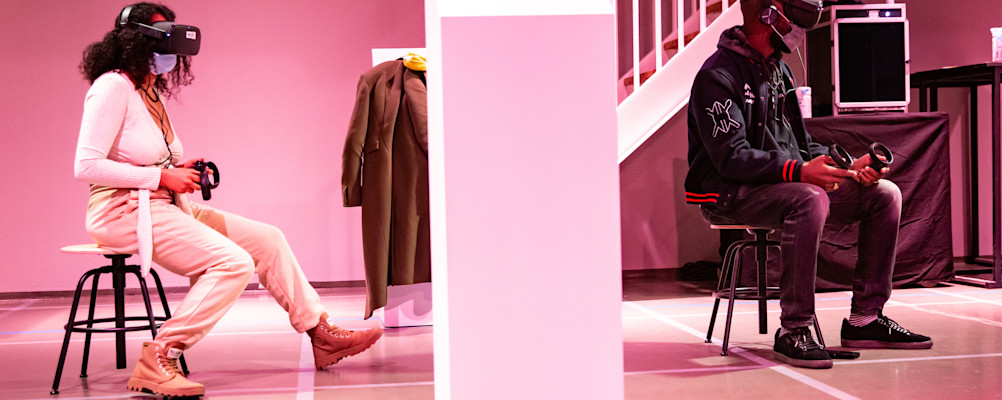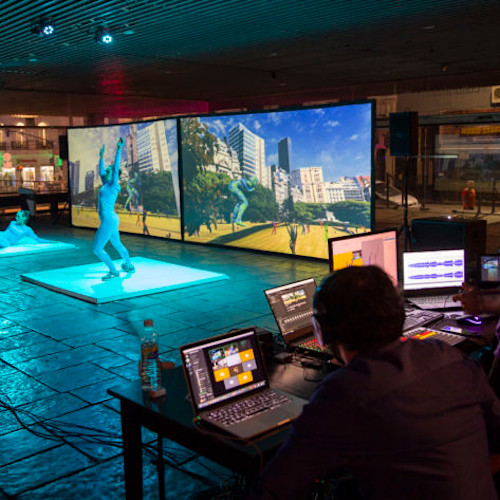The Immersive Network Research & Development programme
IDFA Doclab
IDFA DocLab is a curated interdisciplinary platform for interactive documentary art and storytelling. During International Documentary Film Festival Amsterdam, DocLab offers a wide range of events for anyone interested in the artistic potential of new digital technologies such as artificial intelligence, virtual reality and interactive media. In addition to the festival programme, DocLab has been playing a pioneering role in the development of new forms of interactive media since 2007 with its unique, explorative set-up and continuous R&D-programme: from webdocs, apps and virtual reality to data art, multimedia journalism, installations, live performances and full-dome.
How did IDFA Doclab originate?
IDFA Doclab was born from the question of how the digital revolution and the internet have changed the documentary profession and how it can change it even further in the future.
Caspar Sonnen, Head of New Media IDFA & founder/curator IDFA DocLab: ‘In 2005 the media world looked very different. YouTube, Facebook and Twitter had only just emerged, MySpace was big, Netflix hadn't been invented yet. Internet was starting to get really big. It was then that it became very clear to me that two things were happening with regard to documentaries: on the one hand, people were exploring what the Internet can mean for the film industry as a technological innovation, more as a form of distribution. On the other hand, documentaries were an art form and we could look at the internet as an artistic medium. I then said:’
IDFA DocLab can become a place for new forms of art.
The power of IDFA Doclab: 'On the threshold'
Meanwhile, in its 15th year of existence, IDFA DocLab has grown into a playing field for the investigative documentary maker, where experimental research is conducted into new forms of interactive documentary art and storytelling through a wide repertoire of events. Today IDFA DocLab offers a publicly oriented festival programme - including an annual exhibition in the exhibition spaces of the Tolhuistuin, a VR Gallery and Live Cinema Events - as well as activities aimed at (inter)national professionals in the documentary and new media industry, such as the multi-day Interactive Conference and summit. Within this, various parties - including The Immersive Storytelling Studio (National Theatre), Diversion Cinema, Moniker, Atlas V, Cie Gilles Jobin, Polymorf and Anagram- - investigate the interaction between their work and the visitor. IDFA DocLab thus functions as a test environment in which new insights and developments arise.

Caspar Sonnen: ‘IDFA DocLab is a very good place to together with the public test what works and what doesn't: we put people to work, we motivate them. That's what festivals can do: we don't have to show a media form that always works - it only has to work for one day. In this way we can be a little more radical in our experiments, and more versatile. That is why we do not present one form as the ideal form.
DocLab embraces the space between existing media, between physical and digital. It's about everything that falls between two stools. The power of DocLab is that it encompasses anything that is not traditional media. That's why refer to ourselves as on the threshold.’
Doclab's contribution to the creative industries
What’s special about Doclab is the ongoing R&D-programme, intended for both the Dutch and international documentary industry and related sectors. The R&D programme uses the IDFA festival as a living lab for experiments, research and development. In addition, DocLab supports participants of the R&D programme with its international network, expertise, production capabilities or commissioning budget. The aim of the R&D programme is therefore to boost fundamental research and to develop, stimulate and facilitate artistic innovation, entrepreneurship and cross-sectoral partnerships in the field of immersive and interactive media.
Caspar Sonnen: ‘As a living lab, the R&D programme has a unique infrastructure. Makers are given the space to experiment with different technologies, media and interfaces. Commercial product development is not central, but the public is involved in the process of innovation and development of new productions. In this way we gather new insights and knowledge, which are transferred to the makers and industry as feedback and used for further development of the projects. The innovation process also contributes to discussions about larger societal challenges such as the impact of technology on our behaviour and the physical world.’
A large part of the R&D programme is the ongoing collaboration with Massachusetts Institute of Technology. The MIT Open Documentary Lab will conduct five years of research into the future of interactive and immersive media. The overarching topic here is: new technologies such as VR, AR, MR and AI offer new possibilities for the documentary profession, but how can their full potential be used? Each year, a specific research question is formulated, after which a selection of R&D projects are analysed.
A nice selected R&D project from last year, which DocLab has been following and supporting for several years, is MOTTO. MOTTO is an interactive AR experience on your phone, created by Vincent Morisset. Last year the MOTTO website design was further developed into a live version, which could be broadcast from Morisset's studio in Montreal. During this project, the audience participated in an interactive performance with artists from different countries who joined the event to explore the world of Motto.

Another selected R&D project is Messages to a Post Human Earth by studio Anagram. Originally this project was intended as a physical theatrical installation in a botanical garden, but it was cancelled due to corona. With the physical limitations in mind, this project has been further developed into an imaginative audio tour for two people with Augmented Reality (AR) elements, which you can experience via your phone. With it you go on an adventure together in a local park or forest to rediscover your relationship with the natural world.
The added value of the PPS scheme for Doclab
However, its greatest strength also brings challenges. The free, reactive design of DocLab sometimes makes applying for grants complex: an explorative approach often leads to an unpredictable planning and end product - while those are precisely the things you need to have in many cases to apply for funding.
Caspar Sonnen: ‘In the beginning, we were struggling to define DocLab's set-up. Other people regularly doubted the reasons for existence and the (economic) usefulness. Normally, as a cultural institution, you apply for a subsidy in advance, and then you either receive it or you don't. For us as DocLab, that was difficult from the start, because we can't tell you what we will do a year later. Reality changes very quickly and we continuously respond to that.’
This is precisely why CLICKNL's PPS scheme has played an important role in DocLab's existence for years: with the PPP scheme, subsidy is calculated based on the R&D project investments made in the past year. Those resources can then be reinvested in DocLab's next research year. As a result, the cultural institution retains the freedom to adjust the research project every year.
Caspar Sonnen: “What we like about the PPS scheme is that we can use the subsidy from the previous year for the following year without complex conditions for the entire programme. This creates space to look at what is most urgent to focus on now, regardless of the previous year. That is the advantage of that tiered system for us.’
DocLab's partners also benefit from the PPS scheme. Caspar Sonnen: ‘We enter into practical partnerships with commercial parties, such as VR studios. We give the makers a nudge to do a project, we offer them a guaranteed space and infrastructure. In doing so we can make large projects possible with relatively little support. The PPS programme has been embraced by our partners from the start. It also offers many advantages for them: they see the living lab as a place where they can conduct experiments that they cannot do independently. They can conduct research, have contact with the public and the field and receive feedback from peers.’
What's next?
After fifteen years full of experiences, collaborations and new techniques, DocLab has outgrown the sandbox. They are on the threshold, between puberty and adulthood. In the meantime, there is a strong vision for the (technological) developments of the future and the directions that are interesting for further experimentation. Based on this philosophy, DocLab is exploring a new programme structure in which everything is no longer lumped together.
Caspar Sonnen: ‘The structure will reflect the way the field has developed in recent years. We’ve noticed that a number of “families” or classifications have emerged: digital art, immersive media, physical installations and live performances. We think this new division is useful, although we also identify the border areas between the four.’
DocLab is thus making a stop this year. A structure is being set up within which they can operate for the next 3 years. A structure with a clear direction, within which DocLab manages to maintain its strong identity: a playing field for free, experimental innovation within the documentary industry.
Finished
We asked initiators about impact made:
""In 2022, the pandemic finally loosened its grip on reality, and we were able to return with a We presented DocLab’s biggest and most sensory exhibition and life performance program to date. During 2022, MIT continued and concluded their research into hybrid spaces that support and mix both digital (online) and analogue (‘real world’) encounters.
During the Living Lab of 2022, new audience research was conducted for the next research domain: ‘Prototyping the Future’. ONX Studio and IDFA DocLab collaborated for the first time to present a motion capture stage at the festival: The ONX + DocLab MoCap Stage.
Live performances and workshops invited audiences and professionals to explore the artistic potential of mocap technology for documentary art.
Nu: Reality, an initiative of Cassette in partnership with IDFA DocLab, Diversion Cinema and three Dutch movie theatres in Rotterdam, Haarlem and Nijmegen, created a first-of-its-kind platform for artistically high-quality VR experiences by integrating VR into the daily programming and experience of movie theatres.
Within the same research theme of XR distribution in cinemas, we partnered with the EYE Filmmuseum in Amsterdam to show the entirety of the project Missing Pictures at this location after IDFA. Additionally, DocLab started researching the possibilities of exhibiting XR installations such as FRAMERATE all year round (so not only during the festival/Living Lab).
IDFA will soon be moving its office to the Vondelpark Pavilion (summer of 2023), where DocLab will have a year-round exhibition space at hand, to further push these developments in the future.
Climate change and rising energy prices increasingly affect the world, putting new pressures on everything – including the production and distribution of immersive experiences and the technical infrastructures they require.
This year's living lab not only saw new works that help us discuss and think about these topics in new ways (such as the one-on-one immersive theatre play Horizon), but also saw artists critically reflecting on their own behaviour and the environmental impact of immersive media and researching potential strategies to reduce their carbon footprint.
Together with the National Theatre’s (UK) Immersive Storytelling Studio, we are looking into how we can broaden Horizon’s impact, as it is currently a one-on-one performance. The artists (ScanLAB Projects) that created the project FRAMERATE are researching how new technologies can be used to map and visualize climate change, how the same data can be presented in different ways (such as computational photography), and what works best.
Early 2022, DocLab once more (co-)created hybrid events and hybrid spaces for a.o. Sundance and SXSW. As the pandemic waned, we explored what this meant for platforms like Zoom, VRchat, and Ohyay, and how artists and audiences were shifting away from online events and moving back to physical experiences."



